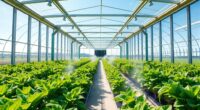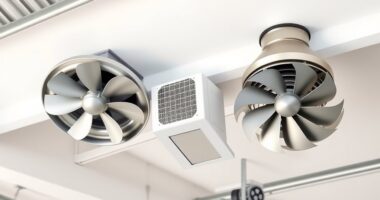When choosing between a greenhouse and a polytunnel, you’ll find notable differences. Greenhouses have robust frames and glass panels, offering better heat retention and environmental control, ideal for delicate plants. In contrast, polytunnels are cost-effective, quick to set up, and flexible in design but may struggle with temperature regulation. Understanding these key distinctions can help you decide which structure suits your gardening needs best. Keep exploring to uncover more insights into their benefits.
Key Takeaways
- Greenhouses feature durable frames and thermal glass for better heat retention, while polytunnels use metal hoops and polythene sheeting for a lower cost.
- Polytunnels are easier to install and can be set up on uneven ground, while greenhouses require a level base and professional installation.
- Greenhouses excel in climate management, providing stable microclimates, whereas polytunnels adapt quickly to weather changes but lose heat rapidly.
- Greenhouses have higher upfront costs but lower long-term maintenance, while polytunnels have lower initial costs but require periodic cover replacements.
- Polytunnels maximize space and are flexible for expansion, while greenhouses offer better humidity control and air circulation for sensitive plants.
Structural Design and Materials

When considering the structural design and materials of greenhouses and polytunnels, it’s crucial to understand their differences.
Greenhouses often feature durable aluminum or metal frames, topped with toughened glass or polycarbonate panels, providing excellent weather resistance. Their various designs, like Victorian styles, add aesthetic appeal but require a perfectly level base for installation.
Greenhouses boast sturdy aluminum frames and glass panels, offering weather resistance and aesthetic charm, but need a level base for setup.
In contrast, polytunnels use simpler metal hoops and are covered with affordable polythene sheeting. Their semi-circular shape allows rain to run off easily and can be erected on uneven surfaces.
Additionally, polytunnels are easier to modify and move, making them adaptable to different growing environments.
Ultimately, your choice depends on your specific gardening needs and preferences.
Cost and Budget Considerations
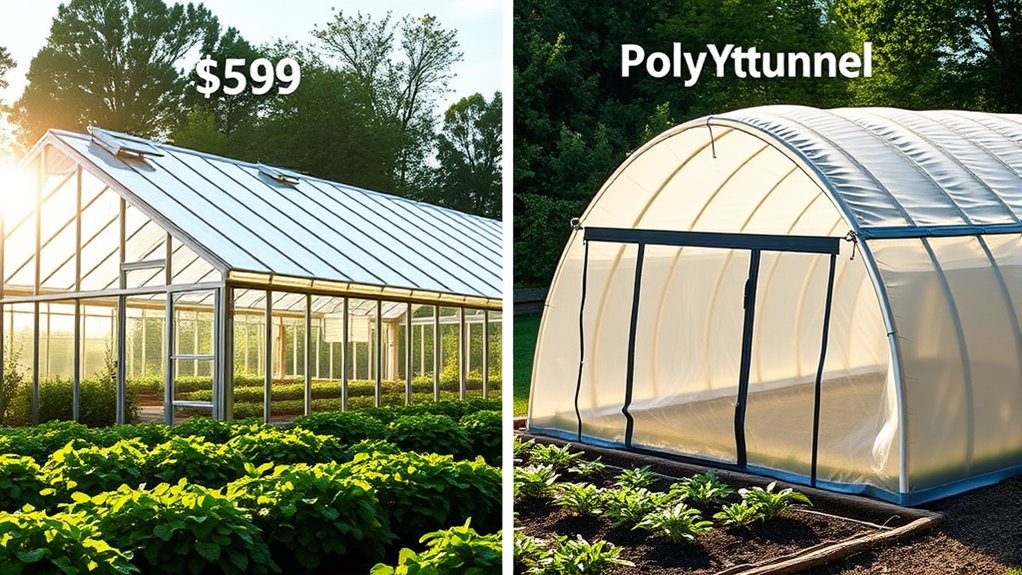
Understanding cost and budget considerations is essential for making an informed decision between greenhouses and polytunnels.
Polytunnels usually come with a lower initial purchase price, often around £400 for sizes like 6×20 feet or 10×12 feet. However, keep in mind that polytunnels require periodic replacement of their polythene covers, adding to long-term costs.
On the other hand, greenhouses, while more expensive upfront, offer durability and lower maintenance costs over time. If you opt for a professional installation for a polytunnel, expect to spend around £230 per day.
Environmental Control and Climate Management
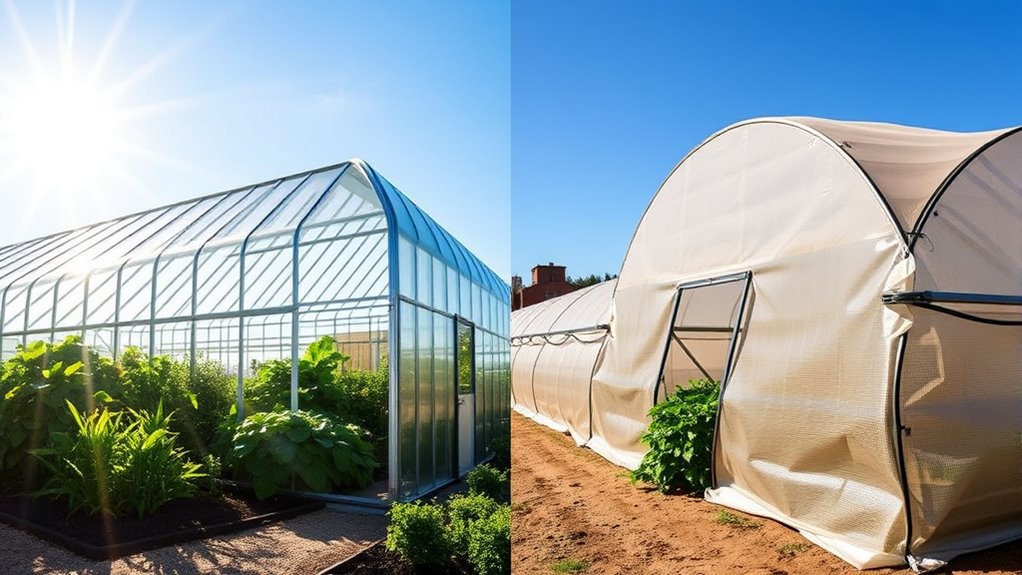
While both greenhouses and polytunnels serve as effective growing environments, they differ considerably in environmental control and climate management.
Greenhouses excel at temperature regulation, thanks to their thermal glass properties, which maintain stable internal climates. They also offer better humidity management and more precise ventilation through roof and side vents.
In contrast, polytunnels adapt quickly to weather changes but lose heat rapidly. They rely on natural light and have less control over light levels.
Greenhouses create stable microclimates ideal for sensitive plants, while polytunnels require proper anchoring to withstand strong winds.
Ultimately, if you prioritize precise climate control, a greenhouse is your best bet, whereas a polytunnel offers flexibility in changing weather conditions.
Space Utilization and Flexibility

If you’re looking for a growing solution that maximizes space and allows for flexibility, polytunnels might be your best option.
They’re cost-effective for larger areas, offering more growing space at a lower price compared to greenhouses. Plus, you can easily extend them by adding more hoops and polythene to adapt to your changing needs.
Polytunnels can even be set up on uneven ground, unlike greenhouses, which require a level base. Setting them up is quicker, and you can customize them with various accessories.
Polytunnels offer quick setup on uneven ground and customizable options, making them a versatile choice for growers.
If you need to move or expand, polytunnels offer that flexibility without major hassle. Overall, they provide a practical space utilization solution tailored to diverse growing projects.
Plant Growth Conditions and Health
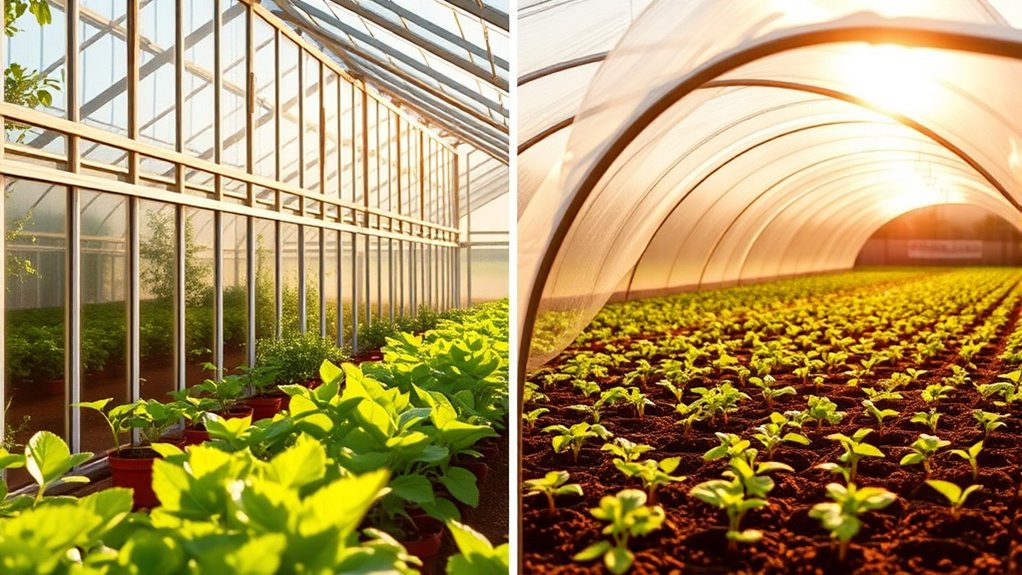
Choosing between a greenhouse and a polytunnel can markedly impact plant growth conditions and health. Greenhouses retain heat better, providing a warmer environment, while polytunnels allow more light, benefiting growth. Both structures need ventilation to manage humidity, but polytunnels adapt quickly to weather changes.
Here’s a quick comparison:
| Feature | Greenhouse | Polytunnel |
|---|---|---|
| Temperature Control | Better heat retention | Faster heat loss |
| Light Transmission | 65-85% light transmission | 88% light transmission |
| Pest Control | More controlled environment | Good airflow |
| Disease Protection | Better disease protection | Moderate protection |
| Air Circulation | Limited ventilation options | Excellent air circulation |
Your choice should align with the specific needs of your plants for ideal growth.
Frequently Asked Questions
How Do Greenhouses and Polytunnels Affect Pest Control?
When it comes to pest control, both greenhouses and polytunnels offer unique advantages.
In a greenhouse, you’ll find solid structures that effectively block pests, making it easier to integrate pest control systems.
On the other hand, polytunnels can be more challenging due to their flexible covers, which may allow pests to enter.
You’ll need to be proactive with inspections and possibly add netting in polytunnels to keep unwanted pests at bay.
What Is the Lifespan of a Polytunnel?
The lifespan of a polytunnel typically ranges from 5 to 20 years, depending on various factors.
If you use high-quality materials and perform regular maintenance, your polytunnel can last closer to 20 years.
However, neglect or poor materials might shorten its life to just a few years.
To maximize its lifespan, keep the cover clean, inspect for damage, and adjust for seasonal changes.
Taking these steps can help you enjoy your polytunnel longer.
Can I Grow All Plants in Both Structures?
You can grow a variety of plants in both structures, but not all plants thrive equally.
Delicate or high-value plants do better in greenhouses, where temperature and humidity control is ideal.
Polytunnels are great for hardier, seasonal crops but mightn’t provide the precise conditions some plants need.
Consider your plant selection carefully and choose the structure that best suits their requirements for the best results in your gardening efforts.
How Do Aesthetics Differ Between Greenhouses and Polytunnels?
When it comes to aesthetics, you’ll notice a clear distinction between greenhouses and polytunnels.
Greenhouses offer a traditional charm with their glass or polycarbonate structures, enhancing your garden’s visual appeal.
In contrast, polytunnels have a more functional, utilitarian look, often characterized by their semicircular shapes and polythene coverings.
If you prioritize style and integration within your landscape, greenhouses definitely hold the edge over polytunnels regarding visual impact.
Are There Any Regulatory Considerations for Installation?
When you’re planning to install a structure, you need to take into account local regulations, check for necessary permits, and guarantee compliance with guidelines.
You’ll want to confirm if your project requires permissions, understand size restrictions, and be aware of location-specific rules.
Don’t forget to verify insurance coverage for your installation, as this can save you from potential liabilities down the road.
Always research before you start, so you can enjoy your new space worry-free!
Conclusion
To summarize, whether you choose a greenhouse or a polytunnel, both have unique advantages that can enhance your gardening experience. For instance, studies show that plants in greenhouses can grow up to 30% faster than those in traditional outdoor gardens. This statistic highlights the potential for increased productivity. Ultimately, your choice depends on your specific needs, budget, and space, so weigh your options carefully to find the best fit for your gardening goals.

